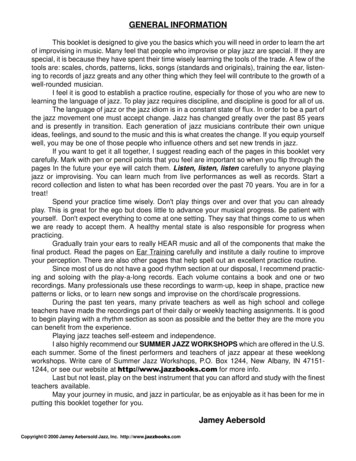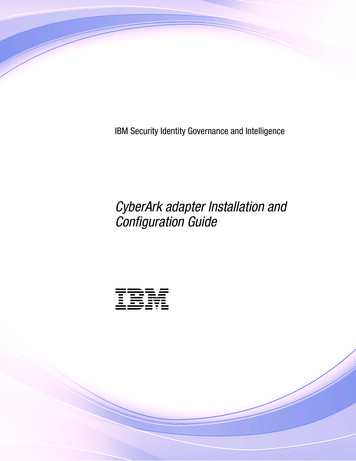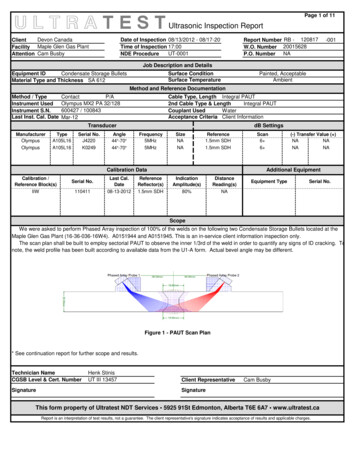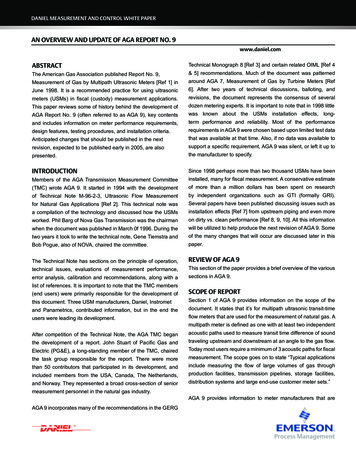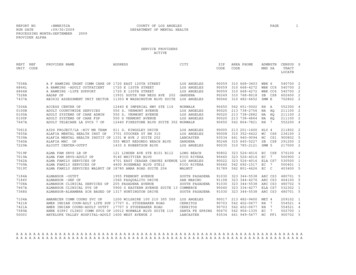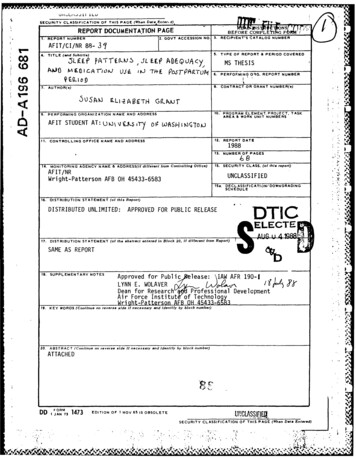
Transcription
Uw.,Lij jiILL'SECURITY CLASSIFICATION OF THIS PAGE (When DataFnrer d),rREPORT DOCUMENTA.TION PAGEBEFORECP&l2. GOVT ACCESSION NO.1. REPORT NUMBERfF63. RECIPIENT'S CATALOG NUMBERAFIT/CI/NR 88- 3'Cc,4.5. TYPE OF REPORT & PERIOD COVEREDTITLE (and Subtitle)5LEEf PATET 1,I jUS-JLIE10.ADQOAcyMS THESISPoS7-PAIZT0T"TE6.PERFOFMING O1G. REPORT NUMBERCONTRACT OR GRANT NUMBER(@)7.AUTHOR(&)S.9.PERFORMING ORGANIZATION NAME AND ADDRESS10. PROGRAM ELEMENT. PROJECT,TASKAREA & WORK UNIT NUMBERSAFIT STUDENT AT: U11.CONTROLLINGiT0',5\1) L AA5 I{0oJOFFICE NAME AND ADDRESS12.REPORT DATE13.NUMBER OF PAGES198814.MONITORING15. SECURITY CLASS. (of this report)AGENCY NAME & ADDRESS(If different from Controlling Office)AFIT/NRWright-Patterson AFB OH 45433-6583. JKUNCLASSIFIEDIS.DECL ASSI ENT (of this Report)DISTRIBUTED UNLIMITED:APPROVED FOR PUBLIC RELEASEELECTE17.DISTRIBUTION STATEMENT(of the abstract entered in Block 20, It different from Report)SAME AS REPORTI.,.IApproved for Publicelease: \IAW AFR 190-ISUPPLIEMENTARY NOTESLYNN E. WOLAVER/0Dean for ResearchProfessional DevelopmentAir Force Institut' of TechnologWright-Patterson AFB OH 45433-65319. KEY WORDS (Continue on reverse aide if necessary and Identify by block number)Z0. ABSTRACT (Continue on reverse side It necessary and Identlfy by block number)ATTACHED-8.-DDJAN731473U!CLASSIFIEtEDITION OF I NOV 65 IS OBSOLETESECURITY CLASSIFICATION OF THIS PAGE (When Data Entered).,., .',""".',,,.,'. , .!.'f " "'' . '. . ., . ' ,-"-(t". "t/"":,'.'. :Sr-c,'
j;{aeth()lttratlwl nil'2I'%,atselarO() Ufr,A is toilrtt \adcS, it. i-I the LIe (4?i.second''htJs(!)et Fielt(A'ereI.arlah lest he .elI1Whajcif;-()Illvltihe Chii u lfli2(Inof(I. wu)lOfal\t heperofitrap()Iart urI the ;eCO'Ild flvi11i Awere th()SaiiIleta'i )Imledicationtl:-Ihusi"ttI rs d av'1."n5hecthe1:-*' 1),p,:i-tftVe'dmiwchl wche) a,11 1,nt the-\%11C) hait 1\ ; ()I illi-]*'those v h1 had nlao)ancst her a and the seppar a mceVSIII ) \WltPdedae .Itrot1t'sVF2(2'.tetdd\.nhp wmU aFF11Ulthe hiIirIn111('eC UN OCc-(2No o ,ni! wantLe ICIt i[heu ei'ci pive -data( l1hitcp Iii nend"1c dc ,I I-1(Attte kut thIICr s let"p 11ir e 1cavcrah!V ntar nc t\niedIeertt%.;L U IU()tSC'rVe I,, er o-,xx1P f I LIrmllill' 1-t etLrc1lauuinsh ps amn-MnindiecIIIW0 ltc 1i a c5-- d c 1meta:","hcW h itC :111t' oM'JIit1to!Il'
ropyof tefr rquiemenstedgreeofNSPCTEI jheissuMitted in partialAf.I--ulillenUnaestr of Wursington II1988Approved by4Z&((.(Chairperson of Supervisory Committee)Program AuthorizedLu Offer DegreeSchool of NursingDateVNN.
VIn presenting this thesis in partial fulfillment of the requirementsfor a Master's degree at the University of Washington, I agree thatthe Library shall make its copies freely available for inspection. Ifurther agree that extensive copying of this thesis is allowable onlyfor scholarly purposes, consistent with "fair use" as prescribed inthe U.S. Copyright Law. Any other reproduction for any purposes or byany means shall not be allowed without my written permission.Signature, J-tvcA4 ,ik ,,.C"iDate.1ipJ-,
University of WashingtonAbstractSLEEP PATTERNS, SLEEP ADEQUACY, ANDMEDICATION USE IN THE POSTPARTUM PERIODby Susan Elizabeth GrantChairperson of the Supervisory Committee:Associate Professor Marcia G. KillienSchool of NursingAlterations in sleep of postpartum women are well documentedphenomena.1A group of 35 healthy postpartum women were studied usingsecondary analysis to describe two sleep parameters and medication useand to identify relationships among these variables.The descriptivedata indicated the use of postpartum analgesia peaked on the firstpostpartum day.On the first postpartum night, 33 of the 35 subjectswere observed to have at lepst one opportunity for sleep; and 24 ofthe 26 subjects on the second night were observed to have at least oneopportunity.On all three self-reported measures of sleep adequacy,the number of subjects who described their sleep more favorablyincreased from the first night to the second.From the chi-squareanalyses, those subjects who had two or more sleep cycle opportunitieson the first night were those who had no labor analgesia or only shortacting analgesia.No significant relationships existed among thetypes of intrapartum anesthesia and the sleep parameters.Thesubjects who had one or two sleep cycle opportunities during the lastthird of the second night were those who were medicated with centralacting analgesia on the first day.No significant associations were% %.4'
found between medication use on the first day and sleep parameters ofthe first night and medication use on the second day and sleepparameters of the second night.The isolated relationships indicatedno consistent patterns between medication use and the sleepparameters.*w. *t ''Sq.SSI
* L-.-ICT IV vu.-.TABLE OF CONTENTSPageList of Tables . . .Chapter I:Introduction . .v. 1Review of' Literature. . . 3Sleep . . . . 3Pregnancy and Sleep. . . 5Nursing Intervention . . 8Analgesia. . . . 8Sedative-Hypnotics. . . 9Hypnotics. . . . 9Purpose of Study. . . . .12Description of Major Concepts. . . .13Chapter II:Methodology. . . .15Sample and Setting . . . . 15Instrumentation . . .16Reliability and Validity . . . .17Procedure . .18. .Chapter III:Results . . . . 19Sample Description . . . . 19Use of Intrapartum Medications . . . .23Analgesia. . . . .23Anesthesia . . .23Uterine Muscle Stimulants . . . .254r,%6,vP'I
Tur&, w)-4-tPageUse of Postpartum Medications . 25Postpartum Sleep Patterns and Sleep Adequacy . 28Intrapartum Analgesia and Sleep Parameters . 30Intrapartum Anesthesia and Sleep Parameters .Postpartum Medication and Sleep.33.34arameters .First Postpartum Night .34Second Postpartum Night .34Chapter IV:Discussion. .Implications for Nursing .Methodological Problems .'.55.56. 58.Appendix A:Subject Data:51. . 53Areas for Further Study .Bibliography . .Record Review .63Appendix B:Morning Sleep Assessment Interview .65Appendix C:Sleep Observation Guide . 66iiii* p'. a a . .- .a-.,* r- .a P a \a%'s'".
LIST OF TABLESNumberPage1.Sample Characteristics .2.Birth Characteristics:3. Birth Characteristics:. .Length of Labor .20. . 21Types of Vaginal Birth .224. Intrapartum Analgesic Use .245.24Intrapartum Anesthetic Use .6. Comparison of Analgesics and Sedative-Hypnoticswith Other Postpartum Medications . .7.Postpartum Medication Use .8.Sleep Patterns:9.Three Characteristics of Sleep Adequacy .10.12.13.14.15.16.17. . 27Sleep Cycle Opportunities . .2931Relationship Between Type of Labor Analgesia and Sleep[''1e Opportunities on tha First11.26Postp!-tum Night32.First Postpartum Day Central Acting Analgesiaand First Night Sleep .35First Postpartum Day Peripheral Acting Analgesiaand First Night Slecp .37First Postpartum Day Sedative-Hypnotic MedicationUse and First Night Sleep .39First Postpartum Day Central Acting Analgesiaand Second Night Sleep . 41First Postpartum Day Peripheral Acting Analgesiaand Second Night Sleep . .43First Postpartum Day Sedative-Hypnotic MedicationUse and Second Night Sleep . .45Second Postpartum Day Central Acting Analgesiaand Second Night Sleep . .47iv
Number18.b%PageSecond Postpartum Day Peripheral Acting Analgesiaand Second Night Sleep. .4
ACKNOWLEDGMENTSThe author wishes to express sincere appreciation to ProfessorsKillien, Lentz, and Blackburn for their assistance in the preparationof this manuscript.In addition, special thanks to Annie Johnson, RN,and Joyce Abbott, LVN whose dedication to quality postpartum nursingcare provided the inspiration for this manuscript.pw%0vivi1It.- I U %% *'\ . IN :N
CHAPTER IINTRODUCTIONThe birth of an infant represents both a beginning and an end inthe lives of the emerging family.Ending is the pregnancy with all ofthe associated physiological and psychological changes.is the fantasy of the child (Rubin, 1984).Ending alsoBeginning is this new lifeas part of the extrauterine environment, involved in new relationshipswith each member of his family.For the postpartal woman, beginningis the time of the most intense physiological and psychologicalchange, the process of healing and regeneration (Rubin, 1961).Forthis process to occur, the parturient must undergo a deep, refreshingsleep (Rubin, 1961).the parturient ".And when her need for sleep has been satisfied,.awakens(Rubin, 1961, p. 752).with a wellspring of trust and faith"If this postpartal sleep is disturbed,however, the regenerative process is delayed, and the parturientexperiences ".what can be best described as sleep-hunger for severaldays" (Rubin, 1961, p. 753).Researchers have identified alterations in the sleep patterns ofwomen throughout the perinatal cycle (Branchey & Petre-Quadens, 1968;Karacan, Heine, Agnew, Williams, Webb, & Ross, 1968; Karacan,Williams, Hursch, McCaulley. & Heine, 1969; Schweiger, 1972).Usingelectronic monitoring techniques in the clinical setting, researchershave documented profound changes in the sleep physiology during thepuerperium (Branchey & Petre-Q adens, 1968; Karacan et al., 1968;Karacan et al., 1969).Self report data from postnatal clients also%g
2has indicated the presence of altered sleep patterns (Schweiger, 1972;Gruis, 1977; Harrison & Hicks, 1983; Killien & Lentz, 1985; Campbell,And when asked to list postpartum concerns,1986; Keefe, 1988).postnatal clients have consistently ranked altered sleep patternsamong their top five (Gruis. 1977; Harrison & Hicks, 1983; S.Blackburn, S. Tribotti, J. Withers, N. Lyons, & M. Stein, personalcommunication, October 9, 1987).The factors most frequently reportedas contributing to these sleep alterations included:physicaldiscomforts (Karacan et al., 1968; Karacan et al., 1969; Schweiger,1972), the presence of the infant (Schweiger, 1972; Killien & Lentz,1985; Campbell, 1986), and nursing care activities (Killien & Lentz,And for all of these factors that contribute to sleep1985).alterations, nursing interventions are appropriate.Nursing plays a vital role in supporting an environment conduciveto sleep.In the medical and surgical care settings, nursinginterventions traditionally focus on physical comfort measures such asrelief from hunger, thirst, and pain, and the provision of a clean,dry, temperate, and quiet environment (Zelechowski, 1977; Stead, 1985:PsychologicaGoodemote, 1985).interventions to enhance sleep suchas expression of feelings and concerns and relief from anxiety are*also common nursing practices on medical and surgical units(Zelechowski, 1977; Goodemote, 1985).However, there are fewdescriptions in the literature about the perinatal nurse'sinterventions when she is faced with the postpartum client's changingOne traditional nursing intervention aimed at thesleep patterns.perinatal client's changing sleep patterns is the administration of*.rS%%S-.
3analgesic and and sedative medications.However, there are fewdescriptions in the literature detailing the frequency of analgesicand sedative use among postpartum clients and how those medicationssubsequently affect both the quality and quantity of postpartum sleep.Because of these discrepancies in the nursing literature relatingmedication administration to effects on postpartum sleep, thisrelationship was studied.Review of LiteratureSleepIt is generally acknowledged that sleep is an integral part ofthe rhythm of our daily lives and is a basic physiological need(Carter, 1985).Sleep, itself, can be divided into two main phases:rapid eye movement (REM) sleep, during which dreaming occurs, and nonrapid eye movement (NREM) sleep.NREM sleep is further divided intofour stages, NREM Stages I, II, III, and IV.Stage I, sleep latency,is the transition between wakefulness and the sleep state.Individuals are easily awakened and may subjectively report that theyare still awake.Stage II follows and is the first clearly definedstage of sleep.Stages III and IV, also referred to as delta sleep,are progressively deeper levels of sleep.It is difficult to awakenan individual from these stages of sleep since it is the deepest sleepof the night.During one cycle of sleep, an individual progressesthrough the NREM and REM stages in approximately ninety minutes.cycle is then repeated approximately five times in an eight hourperiod of time.AI5This'
41970).The exact purpose of sleep is unknown (Hartmann,Sleepresearchers agree that sleep has a restorative function with NREMsleep, especially Stages III and IV, being necessary for basicbiological processes such as tissue repair, recovery from fatigue, andgrowth (Kleitman, 1963; Oswald, 1972; Hartmann, 1973; Adam & Oswald,1983).The role of REM sleep, or frequently referred to asparadoxical sleep, is unclear; however, it has been linked withsynthetic and restorative functions in the brain (Hartmann, 1973) andthe psychological importance of dreams (Dement, 1960; Sampson, 1966).How much sleep is required for optimal function is also notclearly defined by sleep researchers.It appears that che s eeprequirements of individuals vary widely and that for each individualthere is an optimum amount of sleep (Dement, 1972).Hartmann (1970)believes that people subjectively have the impression of needing sleepand that adequate sleep supplies this subjective feeling of beingrested.Hartmann (1970) also believes that sleep serves to optimizeboth physical and psychological functioning. The subjective feelingof whether or not an individual has had a good night sleep isdependent not only on the length of time the individual sleeps butalso on the number of times he wakes during the night (Hartmann,1970).An hour's extra wakefulness is compensated for by additionalamounts of highly restorative NREM sleep and human growth hormone(Beck, Brezinova, Hunter, & Oswald, 1975).Thus, both quality andquantity are important in understanding sleep adequacy.IleW.'W%RrC"a
5Pregnancy and SleepNonpregnant sleep standards cannot be applied to the study ofphenomena observed in pregnancy (Branchey & Petre-Quadens, 1968).Using the physiological parameters of electroencephalogram,electromyography, and eye movements, Branchey and Petre-Quadens (1968)studied seventeen pregnant clients between ten and forty weeksgestation on one to three consecutive nights.Their recordingsindicated an increase in REM sleep beginning from the 25th week,peaking during 33 to 36 weeks, decreasing in the three to four weekspreceding the birth, and returning to normal by the end of pregnancy.IIn the classic study of sleep during pregnancy, Karacan, Heine, Agnew,Williams, Webb, and Ross (1968) investigated sleep patterns duringuncomplicated late pregnancy and the puerperium.Their data indicatedIthat their subjects displayed profound sleep changes which tended tonormalize within two weeks postpartum.Stage I, sleep latency, waslonger before and immediately following birth than that observed inthe control subjects.There was a 100% Stage IV reduction in four ofseven subjects during late pregnancy.All seven subjects showed anincrease in Stage IV beginning on the first postpartum night andreaching normal levels by the second postpartum week.The percentageI.of REM throughout pregnancy was comparable to controls except on thefirst postpartum night when there was a sharp rise in awake time and adecrease in REM.By the third postpartum night, this pattern wasI-reversed with a decrease in awake time and an increase in REM andVapproached nonpregnant normal levels by the second postpartum week.During pregnancy and immediately postpartum, there were alsoI2
6significantly more awakenings for the subjects than for controls.Thesubjects also spent less total time asleep than controls.In 1972, Schweiger set out to determine whether sleep was alteredduring pregnancy and when it was altered from the client'sperspective.He did not base his research on physiologicl deta asBranchey and Petre-Quadens (1968) and Karacan et al.Karacan et al.(1968) and(1969) had, but rather used a subjective survey of 100randomly selected clients at least 38 weeks gestation.His resultsindicated that 69% believed their sleep to be altered, 50% believingthey had less than normal sleep.The number of clients believingtheir sleep to be altered increased during each trimester, with thefewest hours of reported sleep occurring in the third trimester.Also using self report data but in conjunction with observationaldata, Killien and Lentz (1985) set out to describe sleep patterns andsatisfaction in the natural postpartum setting, the hospital.Withoutthe use of electronic monitoring techniques, these authors gathereddata from forty healthy women during the first 48 hours postpartum*usingthe clients' records, structured interviews, and directobservations of sleep.Their results indicated the subjects wereawake 12-69% of the direct observations, with the mean number of awaketimes slightly higher in the first half of the night.Despitefrequent awakenings, morning evaluations were positive, with 67% ofthe subjects describing the previous night sleep as good or excellent.Over 80% felt rested.Keefe (1988) also used self report data during her study5concerningthe influence of newborn rooming-in on maternal sleep atNp."
7night.She studied two groups of mother-infant dyads, one group withinfants rooming-in at night and one group with infants in the nurseryduring the night.In the morning after each night of sleep, hersubjects estimated the total number of hours they slept and rated thequality of that sleep.The results indicated that the rooming-ingroup slept an average of 5.55 hours during the eight hour period.The mothers whose infants were in the nursery slept slightly less,5.35 hours.Mothers in the rooming-in group also reported a slightlyhigher quality of sleep as compared with the mothers whose newborninfants slept in the nursery.Both of these differences, however,were not statistically significant.In examining medicationadministration data, Keefe found that seven of the ten mothers in thenursery group had taken sleep medication, while none in the rooming-ingroup had taken sleep medication.Overall, regardless of the groupassignment, Keefe found the majority of mothers were not satisfiedwith both the amount and the quality of sleep they received in thehospital.From these and other studies on sleep during pregnancy and thepostpartum period, certain factors consistently emerged as influencingmaternal sleep patterns.Karacan et al.(1968) and Karacan et al.(1969) found the number of awakenings were distributed evenlythroughout the night with the need to urinate and episiotomydiscomfort the major reasons for waking.Schweiger (1972) foundurinary frequency, heartburn, general discomfort, cramping, shortnessof breath, and the presence of other children to be the causes ofdisturbed sleep.Killien and Lentz (1985) identified roommate
8activity, the baby present for feeding, and routine nursing caremea
9. performing organization name and address 10. program element. project, task area & work unit numbers afit student at: u \ it 0',5 1) l a a5 i{ 0o j 11. controlling office name and address 12. report date 19




